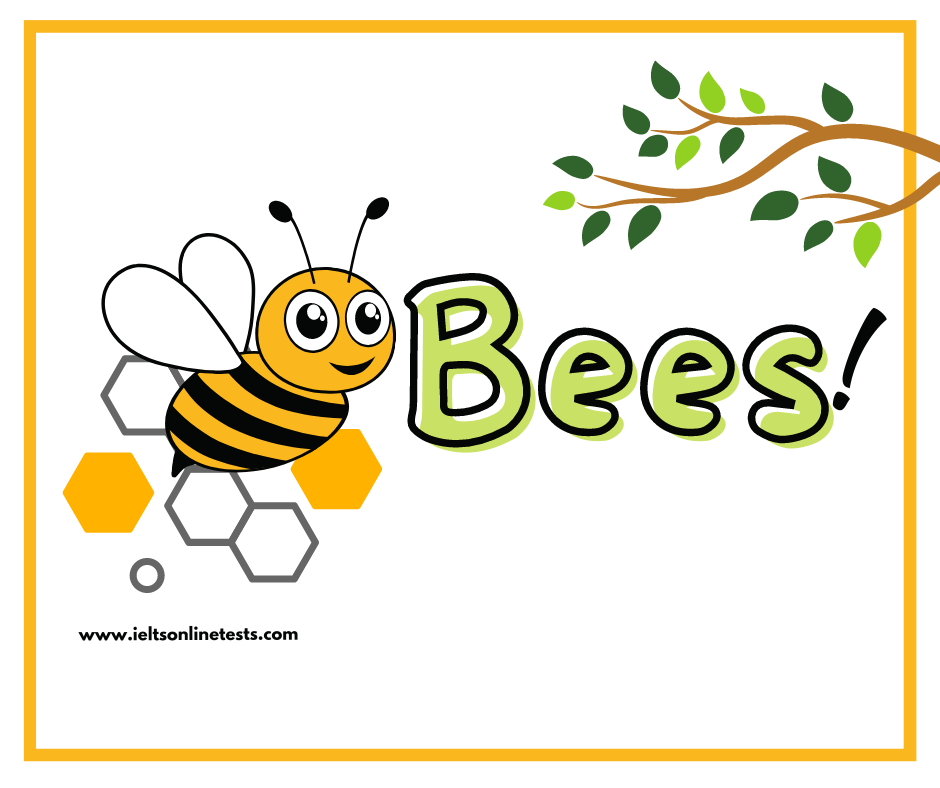
Master IELTS General Training Volume 4
- Published on: 09 Apr 2019
- Tests taken: 298,988
Answer Keys:
Part 1: Question 1 - 14
- 1 southerly
- 2 art scene
- 3 London
- 4 Celtic
- 5 Lanhydrock
- 6 Tin Mine
- 7 D
- 8 A
- 9 A
- 10 C
- 11 forewing / forewings
- 12 antennae
- 13 hindwing / hindwings
- 14 pollen basket
- 1 southerly
- 2 art scene
- 3 London
- 4 Celtic
- 5 Lanhydrock
- 6 Tin Mine
- 7 D
- 8 A
- 9 A
- 10 C
- 11 forewing / forewings
- 12 antennae
- 13 hindwing / hindwings
- 14 pollen basket
Part 2: Question 15 - 27
- 15 printing press
- 16 thousands
- 17 electronic data
- 18 hard copy/a PDF file
- 19 impossible
- 20 e-book
- 21 B
- 22 D
- 23 A
- 24 D
- 25 C
- 26 E
- 27 C
- 15 printing press
- 16 thousands
- 17 electronic data
- 18 hard copy/a PDF file
- 19 impossible
- 20 e-book
- 21 B
- 22 D
- 23 A
- 24 D
- 25 C
- 26 E
- 27 C
Part 3: Question 28 - 40
- 28 Joseph Cleaver
- 29 vocational colleges
- 30 2002
- 31 2004
- 32 London
- 33 5 institutes
- 34 video conferencing technology
- 35 NO
- 36 NOT GIVEN
- 37 NOT GIVEN
- 38 NOT GIVEN
- 39 NO
- 40 YES
- 28 Joseph Cleaver
- 29 vocational colleges
- 30 2002
- 31 2004
- 32 London
- 33 5 institutes
- 34 video conferencing technology
- 35 NO
- 36 NOT GIVEN
- 37 NOT GIVEN
- 38 NOT GIVEN
- 39 NO
- 40 YES
Leaderboard:
| # | User | Score | Time | |
|---|---|---|---|---|
| Marry Sohaib |  | 9.0 | 15:38 | |
| S M Aktaruzzaman |  | 9.0 | 15:45 | |
| Mubarak Syed |  | 9.0 | 15:55 | |
| 4 | Viswa Chaitanya Pinjerla |  | 9.0 | 17:20 |
| 5 | Lina Sornel-Martin |  | 9.0 | 19:24 |
| 6 | Abhi Patel |  | 9.0 | 20:03 |
| 7 | Hoang-Nguyen Nguyen |  | 9.0 | 20:25 |
| 8 | kikidirah101 |  | 9.0 | 20:50 |
| 9 | Zhai Han |  | 9.0 | 20:51 |
| 10 | jiaxiang Liu |  | 9.0 | 20:57 |
Review & Explanations:
Questions 1-6
Complete the sentences below.
Choose NO MORE THAN THREE WORDS from the passage for each answer.
Write your answers in boxes 1– 6 on your answer sheet.
Cornwall has stunning coastal views including the most 1 point in Great Britain.
Apart from the coastal views, the amazing landscapes have inspired an unexpected but thriving 2
Cornwall can now be compared to 3 for its food and amazing chefs.
One thing that makes Cornwall different from the rest of England is its 4 heritage.
The perfect place to discover insights into lifestyles from a bygone era is 5
The perfect place to discover insights into Cornwall's industrial past is a 6
- 1 Answer: southerly
Keywords in Questions
Similar words in Passage
Q1: Cornwall has stunning coastal views including the most … point in Great Britain.
Cornwall is almost completely surrounded by the sea and has a magnificent 300 mile coastline. It is also the location of mainland Great Britain's most southerly promontory.
Note:
From the question, we can assume that the answer must be an adjective. The keyword in this question is Cornwall and its location, so we can easily locate the relevant information in the section Where is Cornwall. As is mentioned, “Cornwall is also the location of mainland Great Britain's most southerly promontory”, we can conclude the answer for Q1 is southerly.
- 2 Answer: art scene
Keywords in Questions
Similar words in Passage
Q2: Apart from the coastal views, the amazing landscapes have inspired an unexpected but thriving …
There's also the dynamic art scene found mainly in West Cornwall, inspired by the naturally stunning landscapes.
Note:
From the question, we can assume that the answer must be a noun. The keyword in this question is unexpected and thriving, so we can easily locate the relevant information in the section Expect the unexpected. As is mentioned, “there's also the dynamic art scene found mainly in West Cornwall”, we can conclude the answer for Q2 is art scene.
- 3 Answer: London
Keywords in Questions
Similar words in Passage
Q3: Cornwall can now be compared to … for its food and amazing chefs.
More recently, Cornwall has become known for a food scene to rival London and beyond.
Note:
From the question, we can assume that the answer must be a noun. The keyword in this question is can be compared to and food. It is mentioned that “more recently, Cornwall has become known for a food scene to rival London and beyond”. We should notice “now” is equivalent to “recently”; “can be compared to” and “rival” are interchangeable”; “food and amazing chefs” is similar to “a food scene”. Therefore, the answer for Q3 is London.
- 4 Answer: Celtic
Keywords in Questions
Similar words in Passage
Q4: One thing that makes Cornwall different from the rest of England is its … heritage.
Cornwall also has a tremendous history based on its Celtic roots; its Celtic Cornish culture; the warmth and friendliness of the people; and the Cornish language that can be seen in the village names. Cornwall is truly unique.
Note:
From the question, we can assume that the answer must be an adjective. It is mentioned in the passage History and Culture that Cornwall also has a tremendous history based on its Celtic roots. We should notice “heritage” is equivalent to “roots” in this case. Therefore, the answer for Q4 is Celtic.
- 5 Answer: Lanhydrock
Keywords in Questions
Similar words in Passage
Q5: The perfect place to discover insights into lifestyles from a bygone era is …
Lanhydrock boasts a magnificent late Victorian country house with gardens and wooded estate. Discover two sides of Victorian life: those 'below stairs', and those ‘upstairs’.
Note:
From the question, we can assume that the answer must be a noun. The keyword in this question is lifestyles from a bygone era. It is mentioned in the passage Lanhydrock – Bodmin that “Lanhydrock boasts a magnificent late Victorian country house with gardens and wooded estate. Discover two sides of Victorian life”. We should notice “Victorian life” can be understood as “lifestyles from a bygone era”. Therefore, the answer for Q5 is Lanhydrock.
- 6 Answer: Tin Mine
Keywords in Questions
Similar words in Passage
Q6: The perfect place to discover insights into Cornwall's industrial past is a …
Housed in two acres of listed buildings, Geevor’s collections and guides bring the story of Cornwall’s rich industrial past to life.
Note:
From the question, we can assume that the answer must be a noun. The keyword in this question is industrial past. It is mentioned in the passage Geevor Tin Mine - near Penzance that “Geevor’s collections and guides bring the story of Cornwall’s rich industrial past to life”. We should notice “the story of Cornwall’s rich industrial past” is similar to “insights into Cornwall’s industrial past”. Therefore, the answer for Q6 is tin mine.
Questions 7-10
Choose the correct letter, A, B, C or D.
Write the correct letter in boxes 7-10 on your answer sheet.
Apart from pollinating crops how else do bees help us?
- A
- B
- C
- D
Keywords in Questions | Similar words in Passage |
Q7: Apart from pollinating crops how else do bees help us? | By pollinating attractive wildflowers like bluebells and poppies, bees also help support the natural environment that people love – benefitting us culturally and economically, as well as ecologically. |
Note: As mentioned in the text “bees benefit us culturally and economically, as well as ecologically”, we can easily conclude that the answer for Q7 is D. | |
Why have the variety of flowers available for bees to pollinate fallen ?
- A
- B
- C
- D
Keywords in Questions | Similar words in Passage |
Q8: Why has the variety of flowers available for bees to pollinate fallen? | This has happened because of the trend towards growing the same crop (monocultures) over large fields. This has reduced the diversity of flowers available. |
Note: As mentioned in the text, “the trend towards growing the same crop (monocultures) over large fields has reduced the diversity of flowers available”, we can assume that the answer for Q8 is A. | |
There are many reasons for the decline in bees but what is one of the major reasons for shrinking numbers of native honey bees?
- A
- B
- C
- D
Keywords in Questions | Similar words in Passage |
Q9: There are many reasons for the decline in bees but what is one of the major reasons for shrinking numbers of native honey bees? | The Varroa mite is thought to be one of the main causes of native honey bee loss. |
Note: The keyword in this question is major reason. It is mentioned in the text that “the Varroa mite is thought to be one of the main causes of native honey bee loss”. We should notice “main causes” and “major reasons” are interchangeable; “native honey bee loss” is equivalent to “shrinking number of native honey bees”. Therefore, the answer for Q9 is A. | |
Why might bees end their hibernation at a different time?
- A
- B
- C
- D
Keywords in Questions | Similar words in Passage |
Q10: Why might bees end their hibernation at a different time? | Climate change has an effect as it can alter the time that bees come out of hibernation |
Note: It is mentioned in the text that “climate change has an effect as it can alter the time that bees come out of hibernation”. We should notice “come out of hibernation” is equivalent to “end their hibernation”; “alter the time” can be understood as “at a different time”. Therefore, the answer for Q10 is C. | |
Questions 11-14
The diagram below shows the worker bee.
Label the diagram.
Choose NO MORE THAN TWO WORDS from the passage for each answer.
Write your answers in boxes 11-14 on your answer sheet.

11
12
13
14
- 11 Answer: forewing / forewings
Keywords in Questions
Similar words in Passage
Q11: Label the diagram.
They have four single wings. The largest are called forewings and the smallest hindwings.
Note:
As described in the first paragraph, “the largest wings are called forewings”, we can easily conclude that the answer for Q11 is forewing(s).
- 12 Answer: antennae
Keywords in Questions
Similar words in Passage
Q12: Label the diagram.
At the front of the head are two antennae for sensing their environment.
Note:
As described in the first paragraph, “at the front of the head are two antennae for sensing their environment”, we can easily conclude that the answer for Q12 is antennae.
- 13 Answer: hindwing / hindwings
Keywords in Questions
Similar words in Passage
Q13: Label the diagram.
They have four single wings. The largest are called forewings and the smallest hindwings.
Note:
As described in the first paragraph, “the smallest wings are called hindwings”, we can easily conclude that the answer for Q13 is hindwing(s).
- 14 Answer: pollen basket
Keywords in Questions
Similar words in Passage
Q14: Label the diagram.
The hind legs are specialized for collecting pollen - each leg is flattened to form a pollen basket near the end of each leg.
Note:
As described in the first paragraph, “each leg is flattened to form a pollen basket near the end of each leg”, we can easily conclude that the answer for Q14 is pollen basket.
READING PASSAGE 1

Bees
Read the text below and answer Questions 1– 6.
It’s hard not to fall in love with Cornwall. For some it’s the happy memories of a childhood seaside holiday. For others it’s the brief fling of a teenage summer. For most it’s a passionate affair that lasts a lifetime...so let the affair begin! Where is Cornwall? Located in the far west of Great Britain, Cornwall is almost completely surrounded by the sea and has a magnificent 300 mile coastline. It is also the location of mainland Great Britain's most southerly promontory, The Lizard, and one of the UK’s most westerly points, Land's End. What’s so special about it? There are lots of things Cornwall is loved for; the dramatic coastline with its captivating fishing harbours; the spectacular beaches and the pounding surf that provide a natural playground for a variety of water sports; and of course the Cornish pasty and cream teas. Expect the unexpected But there are also lots of things about Cornwall that may surprise you. For instance, the wilderness of Bodmin Moor with its panorama of big skies. There's also the dynamic art scene found mainly in West Cornwall, inspired by the naturally stunning landscapes. More recently, Cornwall has become known for a food scene to rival London and beyond. History and culture Cornwall also has a tremendous history based on its Celtic roots; its Celtic Cornish culture; the warmth and friendliness of the people; and the Cornish language that can be seen in the village names. Cornwall is truly unique. Why not visit some of Cornwall's most iconic experiences. From towering castles, beautiful gardens and places steeped in legends and history, you'll be spoilt for choice. Here are a few to get you started. Trebah Garden - near Falmouth One of the great gardens of Cornwall and rated among the 80 finest gardens in the world, discover the magic of this beautiful Cornish valley garden with over four miles of footpath. Lanhydrock - Bodmin Lanhydrock boasts a magnificent late Victorian country house with gardens and wooded estate. Discover two sides of Victorian life: those 'below stairs', and those ‘upstairs’. Geevor Tin Mine - near Penzance Geevor tin mine is one of the largest preserved mine sites in the country and a Cornish Mining World Heritage Site. Housed in two acres of listed buildings, Geevor’s collections and guides bring the story of Cornwall’s rich industrial past to life. |
Read the text below and answer Questions 7– 14.
Worker bees are between 8-19mm in length. They are divided into three distinct parts; head, thorax, abdomen. They have an almost completely black head, a thorax that is golden brown and black with patches of orange, and yellow bands can be easily seen on the abdomen. At the front of the head are two antennae for sensing their environment. They have four single wings. The largest are called forewings and the smallest hindwings. The hind legs are specialized for collecting pollen - each leg is flattened to form a pollen basket near the end of each leg. Love them or hate them, we need bees to pollinate many important food crops, including most fruit and vegetables. Bee pollinated crops are important sources of vitamins A and C, and minerals like calcium. By pollinating attractive wildflowers like bluebells and poppies, bees also help support the natural environment that people love – benefitting us culturally and economically, as well as ecologically. Calculations from the University of Reading show that £510 million of annual total crop sales in the UK are pollinated by bees and other insects. What would happen if there were suddenly no more bees to pollinate these crops? This is a question being asked by farmers, beekeepers, and scientists because bees are now dying in their millions and they want to know why. It’s widely recognised now that changes in agriculture are the main cause of bee decline across Europe. For example, hay meadows, which are full of many different plant species, have declined by 97 per cent since the 1930s, removing an important source of food for bees. This has happened because of the trend towards growing the same crop (monocultures) over large fields. This has reduced the diversity of flowers available and resulted in the removal of hedges. Species that have more specialised food needs, like the Shrill Carder Bee, have been particularly hard hit. It is now listed as an endangered species. With less hedges bees find it more difficult to move between feeding and nesting sites. This is because hedges act as corridors for bees to move along, but with less hedges movement becomes more difficult. Pests and diseases are also a major threat to honey bees and other managed bees. The Varroa mite is thought to be one of the main causes of native honey bee loss. The impact on wild bees is harder to assess but ‘spill-over’ of diseases and pests between wild and managed bees has increasingly been observed. Climate change has an affect as it can alter the timing of plant flowering, or the time that bees come out of hibernation, which means bees may emerge before there is enough food available. |






